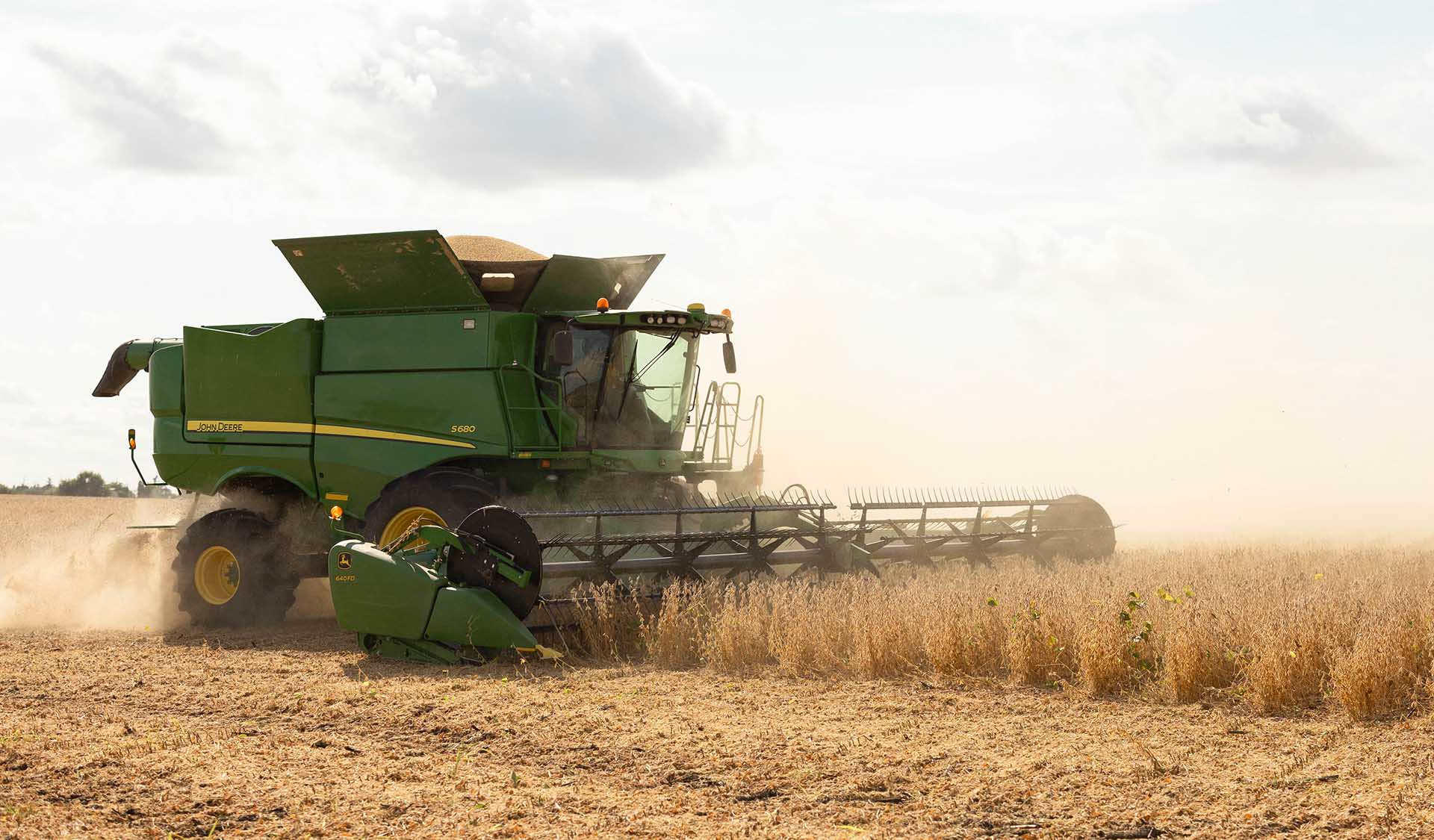
(Photo: Iowa Soybean Association / Joclyn Bushman)
Walking Rows: ISA agronomists update – September 26
September 26, 2024 | Kriss Nelson
Soybean harvest is well underway in most areas of the state, with Iowa Soybean Association research agronomists reporting a range of yields from 60 to 80 bushels per acre. Later-season disease and pests could contribute to those less than-desirable yielding acres.
Drew Clemmensen - Northwest/Western Iowa
Yields on soybean early soybean varieties planted in April are coming in at mid-60 to lower-70 bushels per acre.
Farmers have shared their frustrations with a slow harvest due to the plant is holding onto some greenness and lower leaves, while the soybeans are well below the optimum 13% moisture level.
It seems after a few scattered showers that not only have helped put a little moisture back into the soybeans, soybean harvest is moving more consistently in my area of northwest and western Iowa.

Very little corn has been harvested with yield reports of 220-230 bushels to the acre. Late season disease pressure and a dry August and September have pushed this crop to dry very quickly.
As soon as the crops are off, it is a great time to focus on soil sampling. Soil moisture can have a significant effect on soil fertility test results. It would be ideal to wait until we receive some rain to get some moisture in the soil profile as deep as you are pulling samples.
Keep in mind there is no right or wrong to sampling timing other than consistency. If you typically sample in the fall, try to pull samples in the fall. If you have sampled after a soybean crop for a two-year spread, continue to sample after soybeans. Finally, any sample is better than no sample. Just keep in mind the circumstances of when you pulled that sample so that you can take them into consideration when interpreting the results.
Lucas DeBruin - Southeast/Eastern Iowa
Overall, I would say farmers in the southeast and eastern portion of the state are happy with the yields, just not the prices. Harvesting delays may occur due to early planting in some fields and late planting in others, potentially making this a long harvest season.
Soybeans that looked really good in early August and appeared to have tremendous potential with some early August rains. But, I think a drier late August and early September, definitely took the top end of yields off. However, farmers seem generally pleased with yields and I have been hearing yields around the 80 bushels to the acre mark.

Corn has been yielding 280 to over 300 bushels to the acre for field averages. Those field averages may decline as farmers harvest some of their lower-yielding fields. I have also seen a field go under 200 bushels to the acre this year. There will be thin spots in fields and that will hurt overall yield averages.
If a farmer is not seeing these higher yield numbers, they need to remember the spring we had in some areas and how getting the crop planted and established was a challenge.
There may be some concerns about the dry conditions and cover crops. The farmers I've talked to are continuing their seeding efforts, hopeful that rain will come. Seeds can wait until moisture arrives. A concern arises if they germinate but then die because they don't have enough moisture.
Mikaela Connelly - Southwest/Western Iowa
Early harvest reports for soybeans have been around and more than 65 bushels to the acre in my area, with little corn harvested at this point.
Cover crop seeding is and has been happening across southwest and south-central Iowa, with most applications being farmers drilling or drone applications. These areas also received some rain this past week, which slowed down harvest, but was timely for cover crops.

For fall soil sampling, the ideal time to take the samples would be after harvest, but prior to any fall fertilizer applications. Another consideration would be to sample areas of the field that receive similar management, so if a new product or different fertilizer rate was used across a field, sample areas that are managed the same to ensure accurate comparisons.
Shane Beck - Northeast/Northern Iowa
Corn and soybean fields are coming out quickly in my area. I have heard average soybean yields ranging between 55 and 80 bushels per acre.
A lot of the fields that are on the lower yielding end were hit hard with disease like white mold, had an aphid problem, were too wet this spring or a combination of all.
Overall, the yields are pretty good considering the tough time some of these soybeans had to go through to make it to harvest.
On the corn end, I have heard between 180 and 230 bushels to the acre for average yields so far. Poor planting conditions and later-season disease have led to lower yields in some fields.

This fall has been really dry so far with only a few places catching some rain last week. With the dry conditions, cover crops seeded with a drone or airplane haven’t started to germinate or grow yet. I would like to see at least a 1/2 inch of rain after seeding the cover crop to help germinate the seed and establish it. Most areas have not received this yet, so there may not be much growth to the cover crop when you are out harvesting. Most of it will still grow once it receives that rainfall.
Fall is a great time to soil sample your fields. Farmers should sample their fields every couple of years and ensure there are enough sample points to accurately represent the field and they should conduct sampling before making a fertilizer application.
Besides sampling for nutrients, fall is a great time to test for soybean cyst nematodes (SCN). If you know you potentially have a problem with a field that will go into soybeans, take some samples in the field and get them tested for SCN. Any counts over that 10,000-egg level, we should look at rotating to corn for a couple of years and also looking at resistant varieties once we rotate back to soybeans. By growing corn or another non-host crop for every year, we can reduce the number of eggs by 50%.
Back